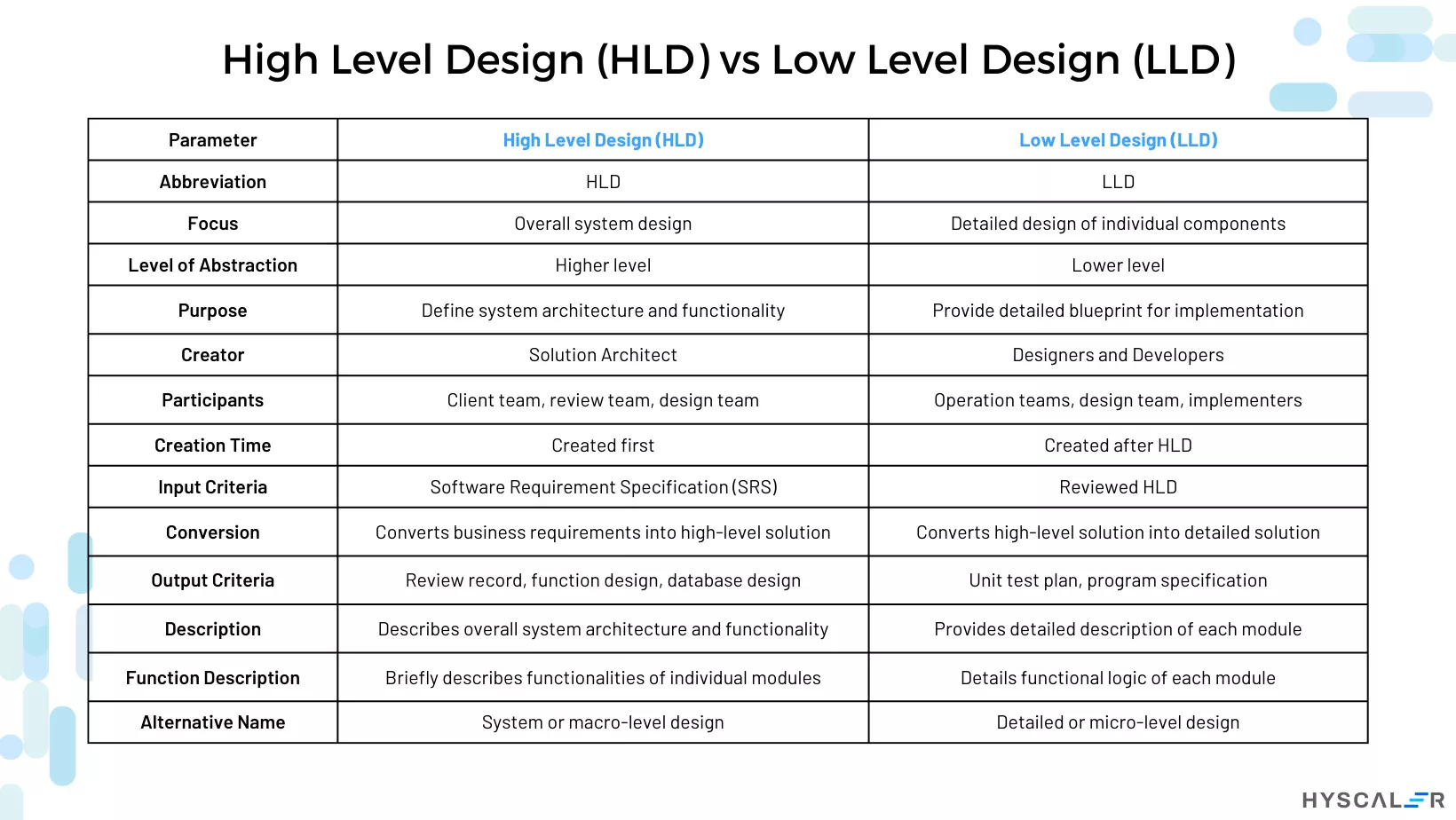Table of Contents
Software development is a complex process that involves multiple stages, each with its unique set of challenges and requirements. Two crucial phases in this process are HLD vs LLD (High-Level Design and Low-Level Design). Understanding the differences between these two phases is essential for effective software development. In this article, we will delve into the world of software design and explore the differences between HLD and LLD.
What is LLD?
Low-Level Design, also known as LLD, involves detailed planning of each component or module outlined in the HLD. It focuses on the specific implementation details, including algorithms and data structures. LLD is concerned with the detailed implementation of individual components, providing a blueprint for programmers to follow. This phase is critical for ensuring that the system is implemented correctly and efficiently
What is HLD?
High-Level Design, also known as HLD, is the conceptual and architectural phase of software development. It outlines the overall system structure, components, and interactions, focusing on the overall functionality and user experience. HLD does not delve into implementation specifics but provides a roadmap for developers. This phase is crucial for effective communication among team members, stakeholders, and clients, as it provides a common understanding of the system’s structure and functionality.
What is SDLC?
SDLC or Software Development Life Cycle is a structured process used by the software industry to design, develop, and test high-quality software. It consists of a detailed plan describing how to develop, maintain, replace, and enhance specific software. The SDLC aims to produce software that meets or exceeds customer expectations, is completed within time and cost estimates, and has high quality.

The typical SDLC includes the following stages:
- Planning and Requirement Analysis: Gathering and analyzing requirements from stakeholders.
- Defining Requirements: Documenting the product requirements in an SRS (Software Requirement Specification).
- Designing the Product Architecture: Defining the high-level system architecture and design.
- Building or Developing the Product: Actual coding and development of the software.
- Testing the Product: Thoroughly testing the software to ensure it meets requirements.
- Deployment: Releasing the software to the customer or end-users.
- Maintenance: Ongoing support and updates to the software
Some common SDLC models include:
- Waterfall Model
- Agile Model
- Spiral Model
- DevOps Model
Key Benefits of High-Level Design in Software Development
Improved Communication and Collaboration
HLD provides a common understanding of the system’s architecture and functionality for all stakeholders, including developers, project managers, and clients. This facilitates effective communication and collaboration throughout the development process.
Better Planning and Risk Mitigation
HLD allows for early identification of potential risks, constraints, and trade-offs, enabling better planning and risk mitigation strategies. This helps ensure the project stays on track and within budget.
Scalability and Maintainability
By defining the overall system structure and interactions, HLD lays the foundation for a scalable and maintainable software solution. This makes it easier to accommodate future changes and expansions.
Faster Development
HLD serves as a roadmap for the development team, guiding them through the implementation process and reducing the time required to translate requirements into a working system.
Reduced Rework
By addressing high-level design decisions upfront, HLD helps minimize the need for costly rework later in the development lifecycle when changes are more difficult and expensive to implement.
Improved Quality
HLD focuses on the overall system architecture and design, ensuring that the final product meets the specified functional and non-functional requirements, leading to higher-quality software.
Separation of Concerns
HLD separates the high-level system design from the low-level implementation details, allowing for a more efficient division of labor and specialized expertise within the development team. In summary, High-Level Design is a crucial phase in the software development lifecycle, providing a solid foundation for the project and enabling more effective planning, collaboration, and execution throughout the development process.
High-Level Design (HLD) vs Low-Level Design (LLD)
High-Level Design (HLD) and Low-Level Design (LLD) are two crucial stages in the software development process. Understanding the differences between these two stages is essential for effective software development.
High-Level Design (HLD)
HLD is a general system design that focuses on the overall architecture and structure of the system. It provides a high-level view of the system, describing the relationship between various system modules and functions. HLD is created by solution architects and involves the following key aspects:
- Scope: It covers the entire system, including system architecture, database design, and user interfaces.
- Level of Abstraction: It operates at a higher level of abstraction, focusing on the overall system design.
- Purpose: The primary purpose of HLD is to define the system’s architecture and ensure that it meets the business requirements and anticipated results.
- Creation: HLD is typically created by solution architects and involves a detailed description of the system architecture, database design, and user interfaces.
Low-Level Design (LLD)
LLD is a detailed design that focuses on the specific implementation details of each component or module outlined in the HLD. It provides a detailed description of each module, including the actual logic for every system component. LLD is created by designers and developers and involves the following key aspects:
- Scope: It focuses on specific modules or components within the system.
- Level of Abstraction: It operates at a lower level of abstraction, focusing on the detailed implementation of individual components.
- Purpose: The primary purpose of LLD is to provide a detailed blueprint for programmers to follow, ensuring the accurate and efficient implementation of the system’s functionality.
- Creation: LLD is typically created by designers and developers and involves converting the high-level design into a more detailed blueprint.
Key Differences: HLD vs LLD

- Scope: HLD covers the entire system, while LLD focuses on specific modules or components.
- Level of Abstraction: HLD operates at a higher level of abstraction, while LLD operates at a lower level of abstraction.
- Purpose: HLD defines the system’s architecture, while LLD provides a detailed blueprint for implementation.
- Creation: HLD is created by solution architects, while LLD is created by designers and developers.
Importance of Both Phases
Both HLD and LLD are crucial phases in the software development lifecycle. HLD serves as a blueprint for the project, guiding the development team’s efforts and providing a roadmap. LLD translates these plans into actionable tasks for programmers, enabling them to implement the system effectively. Both phases are essential for ensuring that the system is developed correctly and efficiently.
Conclusion
In conclusion, understanding the differences between High-Level Design (HLD) and Low-Level Design (LLD) is crucial for effective software development. HLD focuses on the overall system architecture and structure, while LLD deals with the detailed implementation of individual components. By understanding the key differences between these two phases, developers can ensure that their projects are developed correctly and efficiently.